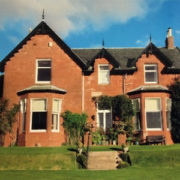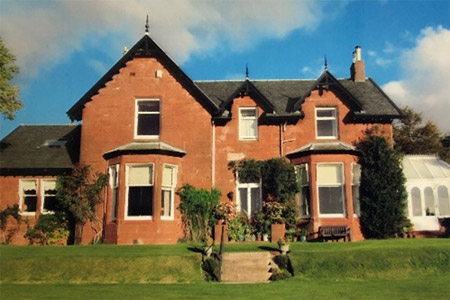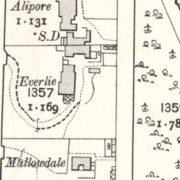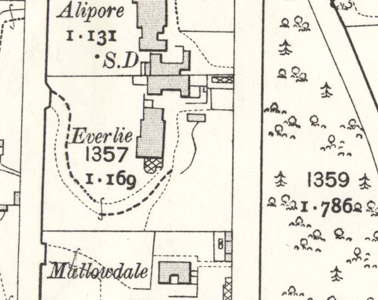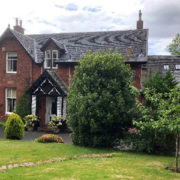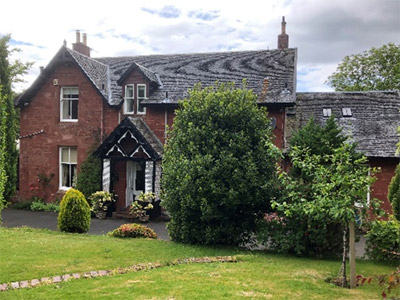7 Montgomerie Terrace, Skelmorlie – “C” listed
Source of photos: 1. The Beeches facing west – courtesy of Mrs Blanche. 2. 1910 Ordinance Survey 3. The Beeches facing East – ND June 2020.
| Owners | Dates | Alterations |
|---|---|---|
| Clement B Dixon | 1874 –1886 | Build commissioned by Clement Dixon*. Architect – John Honeyman. Cost £3,256* |
| Colin W Scott | 1886 – Unknown | |
| Unknown | Circa 1903 -1982 | |
| Robert & Lady Iona French | Unknown -1982 | |
| The Blanche family | 1982 – Present | Replaced and extended conservatory |
* Source: Dictionary of Scottish Architects design report. www.scottisharchitects.org.uk/
Research:
- Clement Dixon, was a wine merchant in Glasgow, who had liquidated his business the year before. In 1873/4, he purchased a plot of land from John Innes, a local builder and developer, who himself had purchased 5 adjoining plots on Montgomerie Terrace. John Innes was subsequently chosen to do the masonry, which cost just under £697. Source Historic Scotland and Mail on Sunday 24 January 2016.
- The house was designed by John Honeyman, one of the foremost architects in Glasgow in the mid-late 19th century, who designed a number of other houses in Skelmorlie including his own, Stroove, in 1868. The house was originally called Everlie and at some point renamed “The Beeches”. Now C-listed, it is largely unaltered and considered a good example of one of Honeyman’s more simple houses. The listing describes it as “Single storey and attic, 4-bay, roughly rectangular-plan, multi-gabled villa with gabled dormers, cast-iron finials and barge boards to E and W-facing gables (including dormers), canted bay windows to W, decorative Gothic timber porch to E, deep bracketed eaves, single-storey service wing to N, and 20th century conservatory to S.” The stable/coach house is considered to be a particularly special survival, as, unlike most of the other stable blocks in Skelmorlie, it has not been converted to a house. The window hoods on the West elevation are also a rare survival. The modern conservatory on the South elevation replaces a slightly smaller one in the same place that was probably original to the house. Source: Historic Scotland
- The Interior has a half-glazed timber paneled inner door to lobby. Round arched marble chimney pieces with projecting keystones to principal ground-floor rooms; some built-in display cupboards. Curved staircase with barley-twist cast-iron balusters and mahogany hand rail and newel post. Slate shelves in larder. Picture rails, embossed paper friezes, decorative cornicing and ceiling roses to principal rooms; plainer cornicing to bedrooms; timber paneled interior doors throughout. Source: Historic Scotland.
- The county directories list Clement B Dixon at Everlie in 1878, 1882 and 1886. By 1893, the listing changes to Colin W Scott although there is a mention of a Donald R McGregor at ‘Everleigh’ in the 1886 Slater’s National Directory. Whether this was another owner or is even the same property is not clear. Source: Post Office County Directories 1878, 1882, 1886, 1893 and Slaters National Directory of Scotland 1886.
- Colin W Scott was part of the Scott’s Shipbuilding dynasty. He was the son of Charles Cunningham Scott (1794 – 1875) and younger brother of John Scott IV (1830 – 1903) and Robert Sinclair Scott (1844 – 1905). The elder brothers jointly managed the firm after the death of their father in 1875. Source: gracesguide.co.uk.
-
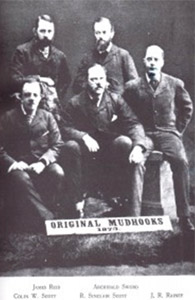
original Mudhooks
Colin Scott was a keen sailor and was instrumental in the set-up of the Mudhook Yacht Club. “In 1873, six friends were going off for a weekend on one of the group’s steam yacht. They were in Boag’s Inn at Fairlie and having a quick one before going aboard while waiting for some of the others to appear. As they were a bit dissatisfied with the clubs around the Clyde, they decided to form a yacht club of their own. This club was to be something special with the main aim being “to encourage Corinthian yachting” and not “to give expensive races for professional skippers steering their employers’ yachts”. They quickly adopted a constitution that included limiting the membership to forty members. Colin Scott became secretary and his brother Robert Sinclair Scott, Admiral of the club. The club still exists today and continues to organise regattas on the Clyde. Sources: mudhookyc.co.uk and www.maritimeviews.co.uk.
-

silver shield – Skelmorlie’s Bowling Club
In 1898, Colin donated a large silver shield to Skelmorlie’s Bowling Club. The shield is still played for today and is awarded to the bowler with the highest aggregate points over the season. In the early days, the winners of the shield appear to have been given a small silver shaped badge to retain. This one 38 x 30mm was for sale in 2004, with the name R Cunningham, 1898 on the reverse. Source: dnw.co.uk/special collection and Skelmorlie Bowling Club
- Colin W Scott continued to be listed at Everlie in 1896, 1901 and 1903. No information or dates have been found regarding the owners of Everlie between Colin W Scott and Robert & Lady Iona French, nor when the house named changed to “The Beeches”. Source: Post Office County Directories 1896, 1901 & Slaters National Directory of Scotland 1903.

